 THE MINERAL APATITE
THE MINERAL APATITE
- Chemistry: Ca5(PO4)3(OH,F,Cl), Calcium (Fluoro, Chloro, Hydroxyl) Phosphate
- Class: Phosphates
- Group: Apatite
- Uses: as a source of phosphorous to be used in fertilizer, rarely as a gemstone and as a mineral specimen.
Specimens
An irony of the name apatite is that apatite is the mineral that makes up the teeth in all vertebrate animals as well as their bones. Get it? Apatite - teeth! Anyway, the name apatite comes from a Greek word meaning to decieve in allusion to its similarity to other more valuable minerals such as olivine, peridot and beryl.
Apatite is widely distributed in all rock types; igneous, sedimentary and metamorphic, but is usually just small disseminated grains or cryptocrystalline fragments. Large well formed crystals though can be found in certain contact metamorphic rocks. Very gemmy crystals of apatite can be cut as gems but the softness of apatite prevents wide distribution or acceptance of apatite as a gemstone.
PHYSICAL CHARACTERISTICS:
- Color is typically green but also yellow, blue, reddish brown and purple.
- Luster is vitreous to greasy and gumdrop.
- Transparency: Crystals are transparent to translucent.
- Crystal System is hexagonal; 6/m
- Crystal Habits include the typical hexagonal prism with the hexagonal pyramid or a pinacoid or both as a termination. Also accicular, granular, reniform and massive. A cryptocrystalline variety is called collophane and can make up a rock type called phosphorite and also can replace fossil fragments.
- Cleavage is indistinct in one basal direction.
- Fracture is conchoidal.
- Hardness is 5.
- Specific Gravity is approximately 3.1 - 3.2 (average for translucent minerals)
- Streak is white.
- Associated Minerals are hornblende, micas, nepheline and calcite.
- Other Characteristics: An unusual "partially dissolved" look similar to the look of previously sucked on hard candy.
- Notable Occurrences include Durango, Mexico; Bancroft, Ontario; Germany and Russia.
- Best Field Indicators are crystal habit, color, hardness and look.
 Amethyst Galleries' Mineral Gallery MINERALS |
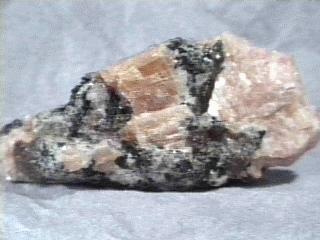
$ 49.00
Dims: 7-1/4" x 4" x 3-1/4"
Wt: 3 lbs., 9.8 oz
Ontario, Canada
This large and colorful Canadian specimen(I'll get the exact locality soon) consists of a matrix that is primarily composed of a pinkish-orange calcite that has many small crystals of hornblende and a few large Apatite crystals. Most of the Apatite crystals are fractured and broken(the same goes for the hornblende), but a few are intact, showing hexagonal form and rounded but definable terminations. They have a strange color that is a blend of green and red and have a vitreous to pearly luster. The largest of these measures about 1-1/2 inches long and is over 50% embedded in the calcite(see the close-up). The calcite itself appears massive but has a clean cleavage, forming rhombic faces. In some areas it closely "interacts" with the hornblende, which forms short, black, pseudotrigonal prismatic crystals with a vitreous luster. I bought one of these and started to pick the calcite away with a steel dental probe, exposing a few really nice Apatites.


Ontario, Canada
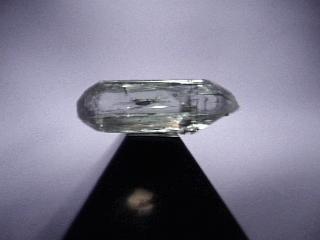
APATITE specimen apa-2
$ 30.00
$ 30.00
Dims: 0.8" x 0.3" x 0.2"
Wt: 1.9 g
Sceptre Claim, Emerald Lake, Yukon, Canada
A singular crystal, this Canadian Apatite specimen is quite pretty, and has a special quality to it. First, it is transparent, with a few large internal fractures running along its length, and is free of cloudiness or veils. It has a small amount of noticeable damage to one termination(yes, it is double-terminated!). The second termination, though incomplete due to the matrix that the crystal formed on, is quite definite and well-formed with almost no human-induced damage. The crystal's color is a pale olive-green and it has a vitreous luster on its prism faces and a pearly luster on its termination faces. These terminaton faces have some bizarre striations along their edges. It comes with a plastic specimen box that it can be glued into.

apa-2 ($ 30.00)
Sceptre Claim, Emerald Lake, Yukon, Canada
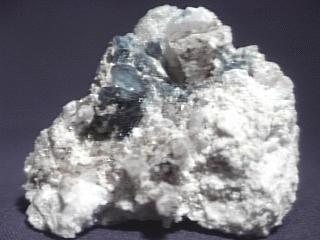
APATITE specimen apa-3
$ 45.00
$ 45.00
Dims: 2.7" x 1.5" x 1.3"(6.9 x 3.8 x 3.3 cm)
Wt: 3.54 oz.(100.4 g)
Parelhas, Rio Grande do Norte, Brazil
There are several hexagonal tabular platelets of Apatite on this Brazilian specimen. They all have a moderate blue color, vitreous luster, and are transparent and very clear, approaching gem-quality! They range in size from a few millimeters to about 0.5"(1.3 cm) in diameter, and are no thicker than 3 mm. All are protruding from the host rock and intergrown, so that no complete and individual crystals are visible. They rest on a base of albite along with a substantial amount of muscovite and several quartz crystals- they are intergrown with a few. Many of the crystals are damaged or broken, but there are several that are intact and very beautiful.


apa-3 ($ 45.00)
Parelhas, Rio Grande do Norte, Brazil

APATITE specimen apa-4
$ 20.00
$ 20.00
Dims: 1.7" x 0.7" x 0.6"(4.3 x 1.8 x 1.5 cm)
Wt: 19.8 g
Durango, Mexico
A single, yellow Apatite crystal constitutes this Mexican specimen. It has the classic hexagonal prismatic form whose 6 prism edges have been truncated by secondary faces. It has a shallow hexagonal pyramidal termination with obvious damage to two faces. There is also one impact scar with a small amount of conchoidal fracturing on one prism edge, but the crystal's form is still quite good, with clean edges and faces. It has a vitreous luster and is transparent, though its interior is heavily fractured. There is a much smaller crystal with considerable damage but almost no internal flaws that is partially grown into the larger one near its base. I have always liked these large, yellow Apatite crystals, even though they're considered common.

apa-4 ($ 20.00)
Durango, Mexico
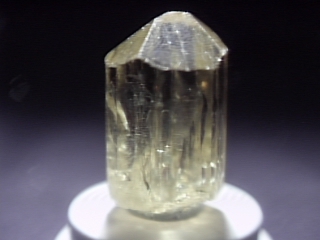
APATITE specimen apa-5
$ 20.00
$ 20.00
Dims: 1.0" x 0.6" x 0.5"(2.5 x 1.5 x 1.3 cm)
Wt: 9.6 g
Durango, Mexico
Though rather small, this Apatite crystal is very beautiful, with excellent form and little damage. It has a rather warped hexagonal crystal form whose twelve prism faces are not quite symmetrical. It is topped with a shallow hexagonal pyramid, and the only damage that I can see on the cryastal are one small, old(it occurred before it was unearthed) break, and some tiny conchoidal "dings" on some of the edges. It has a yellow color with a slight hint of green, a vitreous luster, and is transparent. Internal fractures run along its prism length and most of them stop just short of the pyramid, which is nearly flawless. This may be right for a younger mineral collector that is beginning to buy more serious specimens.

apa-5 ($ 20.00)
Durango, Mexico
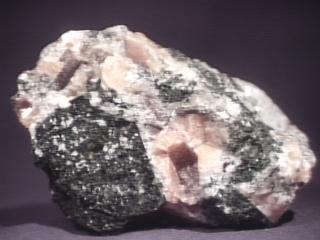
APATITE specimen apa-6
$ 25.00
$ 25.00
Dims: 4.6" x 3.2" x 2.2" (11.7 x 8.1 x 5.6 cm)
Wt: 1 lb., 5.6 oz. (597 g)
Ontario, Canada
Maybe I should have classified this specimen as a "hornblende", because there is a huge crystal embedded in it, but since there are several green-red Apatite crystals that are also visible in the orange calcite host rock, I decided to stick with them. They are in generally good condition, though there are several broken crystals on the piece, and the largest complete crystal measures at least 0.8" (2.0 cm) in length. All have a hexagonal prismatic form with warped, complex dome terminations and show a pearly luster. They are translucent, but this is not easy to determine- small areas in any given crystal may be transparent, but most are filled with concentrated internal fracturing. Just out of interest, the largest of the several hornblende crystals that accompany the Apatites has dimensions of 2.1 x 2.0 x 1.8" (5.3 x 5.1 x 4.6 cm), and is heavily damaged and not quite complete, like most of the others. The host rock consists of a massive orange-colored calcite.
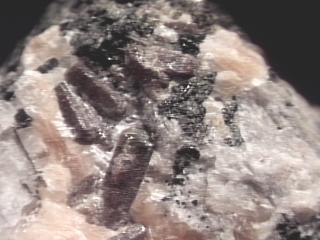

apa-6 ($ 25.00)
Ontario, Canada
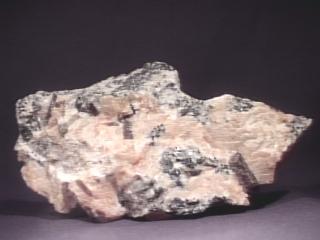
APATITE specimen apa-7
$ 42.00
$ 42.00
Dims: 7.5" x 4.3" x 2.0" (15.1 x 10.9 x 5.1 cm)
Wt: 2 lbs., 12.0 oz. (1.247 kg)
Ontario, Canada
At least 15 hexagonal prismatic Apatite crystals protrude from the host rock of this Canadian specimen. They are in generally good condition, though a few are obviously broken, and reach a maximum length of 0.9" (2.3 cm). Their color is a strange combination of red and green and their luster is pearly. The crystals' form is good, though their complex domed terminations are usually quite warped. They seem to range from translucent to opaque in clarity, but there may be some definite patches of transparence; one can at least see that each crystal is heavily internally fractured. The host rock consists of a chunk of massive calcite with a rather bright, orange coloration in which are lodged scores of small black hornblende crystals. There is a rounded depression in one side of the specimen where a drill or borer sank into the rock.


apa-7 ($ 42.00)
Ontario, Canada
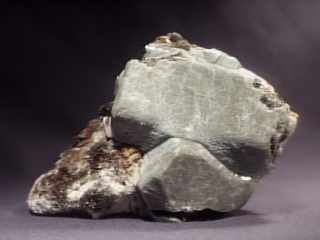
$ 100.00
Dims: 5.6" x 3.9" x 2.7" (14.2 x 9.9 x 6.9 cm)
Wt: 1 lb., 14.3 oz. (858 g)
Minas Gerais, Brazil
Though there are at least 7 discernable Apatite crystals on this specimen, most are so heavily intergrown with the largest one that they are not really worthy of mention. The two largest crystals make up the bulk of the Apatite on this piece. They both show considerable damage but have reasonably good hexagonal prismatic form, with rounded but definite edges and smooth faces that show a pearly luster. They are opaque and show a pale green-gray coloration on their surfaces. The damage, though detracting some from the piece, allows one to see that the crystals' pale green coloration is due to a relatively thin coating. Their interior consists of material that has a very dark, brown-green coloration. The Apatites rest on a pegmatite base that is made up of a combination of albite, quartz, and muscovite. The muscovite occurs in several well-formed hexagonal "books", and shows only a small amount of damage. It is one of the more impressive Apatite specimens that I have had the pleasure to study, and its layering is quite intriguing.
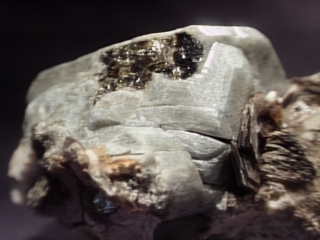

Minas Gerais, Brazil
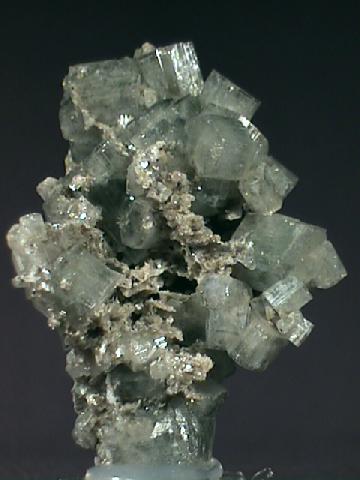
APATITE specimen apa-9
$ 120.00
$ 120.00
Dims: 2.4" x 1.7" x 1.4" (6.1 x 4.3 x 3.6 cm)
Wt: 2.59 oz. (73.6 g)
Panasqueira Mine, Barroca Grande, Beira Baxia, Brazil
At least 30 separate and distinct Apatite crystals are intergrown to make up the bulk of this small hand specimen. They are in pristine condition- I have closely examined the piece, and can detect only one obvious spot of damage! The crystals range in size from less than 0.1" (3 mm) in any dimension up to the largest, which is only partly exposed and has visible dimensions of 0.7" (1.8 cm) in diameter x 0.6" (1.5 cm) in length. All have a reasonably good hexagonal prismatic form and tend to be capped with double basal terminations. They have a very pale greenish-gray coloration and a bright, pearly-to-vitreous luster. All are translucent, cloudy, and show considerable internal fracturing, though these fractures do not tend to reach the surface. There are many tiny muscovite platelets scattered over the piece- they tend to be loosely intergrown into groups. The specimen is hot-glued onto a small, square acrylic base

apa-9 ($120.00)
Panasqueira Mine, Barroca Grande, Beira Baxia, Brazil
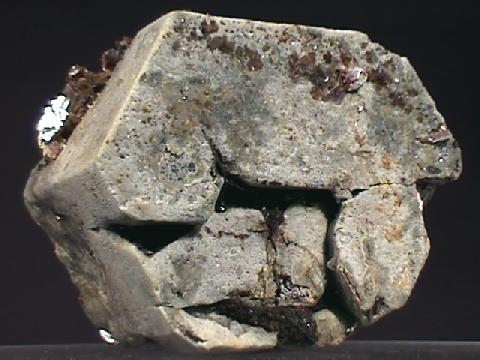
APATITE specimen apa-10
$ 45.00
$ 45.00
Dims: 2.8 x 2.2 x 2.2" (7.1 x 5.6 x 5.6 cm)
Wt: 14.0 oz. (395 g)
Minas Gerais, Brazil
This hand specimen consists of a single hexagonal prismatic Apatite crystal that is in very good condition; the crystal shows almost no human-induced damage. Its form has a few highly unusual aspects, though- one of its terminations is malformed and quite odd. This termination is definitely pyramidal in shape (see the close-up image), though a few of its faces are rounded and spoiled due to the crystal's intergrowth with several books of mica and many albite blades. The termination is capped by a small basal face that has a hexagonal shape and a triangular hole extending about 0.5" (1.3 cm) down into it. The other termination is made up of a somewhat disheveled but regular basal termination into which are intergrown several small muscovite books. The crystal has an odd, pale gray-green coloration and a dull, waxy-to-matte luster. It is thoroughly opaque.
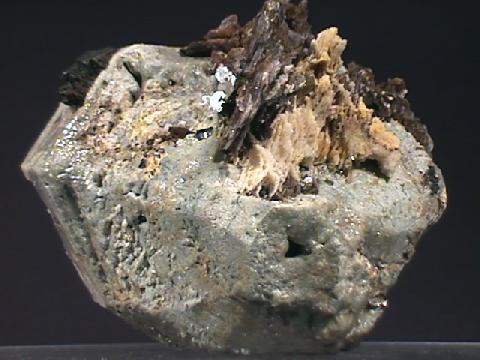

apa-10 ($ 45.00)
Minas Gerais, Brazil
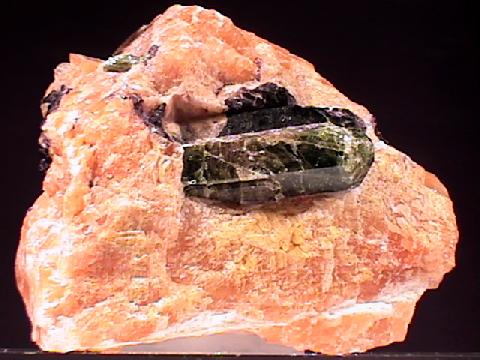
APATITE specimen apa-11
$ 80.00
$ 80.00
Dims: 3.9 x 3.2 x 3.1" (9.9 x 8.1 x 7.9 cm)
Wt: 1 lb., 11.3 oz. (775 g)
Bancroft, Ontario, Canada
A single large Apatite crystal rests among shards of other crystals in the calcite host of this specimen. It is in good condition, showing only a small amount of damage near its termination, and has visible dimensions of 1.7 x 0.7 x 0.7" (4.3 x 1.8 x 1.8 cm). Its hexagonal prismatic form is very good, with moderately well-defined edges and very clean faces that possess a bright pearly-to-vitreous luster. The crystal has a moderately deep forest-green coloration with a hint of brown, and is dimly translucent in its present state when viewed under a halogen light. Intense internal fracturing causes only small areas of the crystal to be noticeably transparent. The surrounding shards have either a similar green or a deep violet coloration, and the calcite host is moderately bright orange in color. It is one of the larger Apatite crystals that we have had available from this locality.

apa-11 ($ 80.00)
Bancroft, Ontario, Canada

APATITE specimen apa-12
$ 70.00
$ 70.00
Dims: 1.7 x 1.5 x 0.7" (4.3 x 3.8 x 1.8 cm)
Wt: 1.21 oz. (34.4 g)
Liscombe Deposit, Monmouth Township, Wilberforce, Ontario, Canada
A single complete Apatite crystal is partly embedded in the calcite host rock of this thumbnail specimen. It is in excellent condition, showing damage only near its base, where the specimen was separated from its place of formation. Its form is likewise excellent, with relatively well-defined edges, though its termination edges are somewhat rounded. Its faces are lightly striated and very clean, and reflect a bright, nearly vitreous luster. It has a moderately pale green coloration and is transparent and moderately clear, as rather intense internal fracturing provides much interference. The pale orange calcite host that holds it also contains shards of a few other Apatite crystals, but these are less than 50% complete. The piece is hot-glued onto a flat, square acrylic base.

apa-12 ($ 70.00)
Liscombe Deposit, Monmouth Township, Wilberforce, Ontario, Canada

APATITE specimen apa-13
$ 80.00
$ 80.00
Dims: 3.6 x 2.3 x 2.0" (9.1 x 5.8 x 5.1 cm)
Wt: 9.70 oz. (275.2 g)
Casapalca, Peru
One of the oddest Apatite specimens that I have seen, this piece consists of two partly intergrown sprays of parallel and intergrown Apatite prisms. One of these sprays is heavily damaged- every crystal therein is broken and incomplete. However, the other cluster is in excellent condition and contains crystals that are 1.7" (4.3 cm) long. Their hexagonal cross-section is evident, but their intergrowth has warped their form. All have crystalline but very uneven terminations, but their prism edges are well-defined and their faces are striated but clean and show a bright, pearly-to-vitreous luster. Their color is especially interesting- when I first saw them, I thought that they were amethysts because they possess a pale violet color at their bases that fades to near colorlessness at their terminations. The cluster is essentially translucent, but individual crystals show patches of transparence. The clusters rest on what appears to be a layer of crystalline calcite, which in turn partly coats a base rock that is rich in metallic sulfides, especially pyrite, chalcopyrite, and galena.


apa-13 ($ 80.00)
Casapalca, Peru
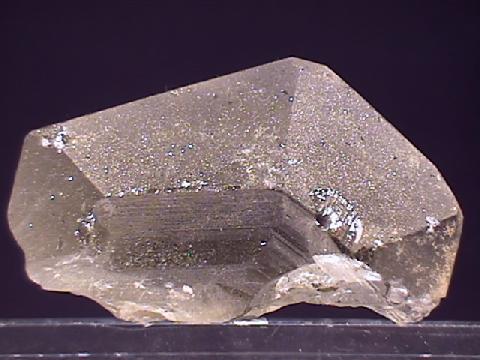
APATITE specimen apa-14
$ 75.00
$ 75.00
Dims: 2.3 x 1.3 x 1.0" (5.8 x 3.3 x 2.5 cm)
Wt: 3.4 oz. (96.5 g)
Neosla, Basha Valley, Baltistan, Northern Areas, Pakistan
Part of a large Apatite crystal makes up this small hand specimen. It consists of a portion of the termination area, and all but two secondary termination faces are incomplete. However, the crystal itself did not completely form due to growth restrictions, so most of the natural termionation is actually present. It shows a substantial amount of damage due to its separation from its place of formation, and a small amount of other human-induced damage is present in the form of chipped edges. What hexagonal prismatic form it has is quite good, with well-defined edges and often frosted but clean faces, a few of which possess the standard pearly-to-vitreous luster. Its color is a rather dull olive-green with a hint of gray or blue, and it is transparent and surprisingly clear in large areas of its interior. There is no host rock present. One could conceivably use this crystal for faceting material, but it is certainly suitable for a specimen.
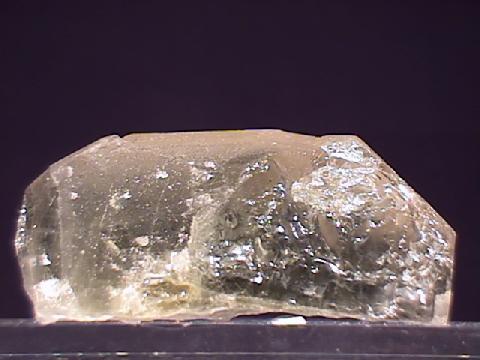

apa-14 ($ 75.00)
Neosla, Basha Valley, Baltistan, Northern Areas, Pakistan
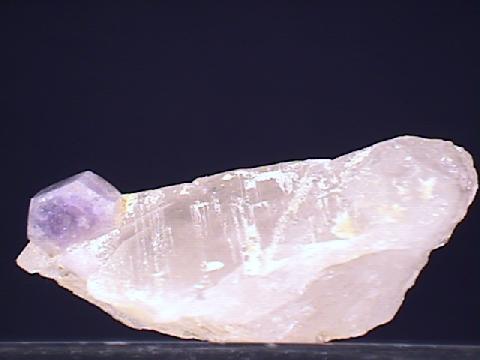
APATITE specimen apa-15
$ 25.00
$ 25.00
Dims: 1.3 x 1.0 x 0.6" (3.3 x 2.5 x 1.5 cm)
Wt: 11.5 g
Apaligun, above Dassu, Baltistan, Northern Areas, Pakistan
A single, small Apatite crystal rests on the dull white base of this thumbnail specimen. The crystal measures 0.2" (5 mm) thick and 0.3" (8 mm) in diameter, and is in excellent condition, showing no damage whatsoever. Because of its dimensions, one can almost say that its hexagonal form is tabular rather than prismatic. Its edges are moderately well-defined and its faces are clean, possessing a pearly luster. Its pale violet color is likely its most unusual trait. It is moderately translucent due to many cloudy inclusions and internal fractures, but shows a small glimpse of dim transparence in one or two spots. There are actually two other Apatite crystals present, but one of these is broken and incomplete and the other is much smaller than the aforementioned, and is partly intergrown with it. The base on which they rest is made up of part of a quartz crystal- portions of two prism faces are present, along with a small amount of muscovite.

apa-15 ($ 25.00)
Apaligun, above Dassu, Baltistan, Northern Areas, Pakistan
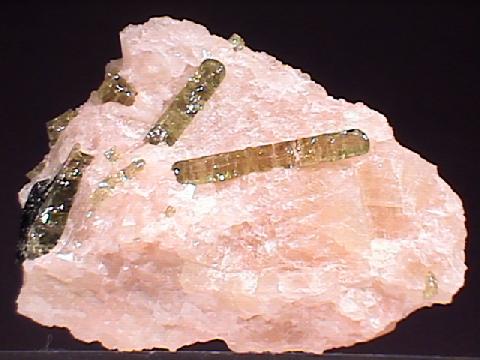
APATITE specimen apa-16
$ 135.00
$ 135.00
Dims: 3.4 x 2.8 x 1.5" (8.6 x 7.1 x 3.8 cm)
Wt: 8.11 oz. (230.1 g)
Liscombe Deposit, Monmouth Township, Wilberforce, Ontario, Canada
I count 13 separate and distinct Apatite crystals on this hand specimen, one of which is damaged, and 7 of which are broken and incomplete. Those that are intact, however, are in excellent condition and have dimensions of up to 1.5 x 0.2 x 0.2" (3.8 x 0.5 x 0.5 cm). Their hexagonal prismatic form is good, with rather rounded, shallow hexagonal pyramidal terminations- the two largest intact crystals appear to be doubly-terminated. All have slightly rounded edges and striated but clean faces that possess a bright pearly luster. They have a pale yellow-green color and are transparent and very clear, though each contains many basal-oriented internal fractures. They are accompanied by a single, badly broken hornblende crystal, and are embedded in a host of pale orange calcite.

apa-16 ($135.00)
Liscombe Deposit, Monmouth Township, Wilberforce, Ontario, Canada

APATITE specimen apa-17
$ 127.00
$ 127.00
Dims: 2.1 x 1.9 x 0.9" (5.4 x 4.7 x 2.4 cm)
Wt: 1.7 oz. (49 g)
Liscombe Deposit, Monmouth Township, Wilberforce, Ontario, Canada
This hand specimen consists of a chunk of calcite host rock in which is partly embedded a single Apatite crystal. The crystal has dimension of 1.5 x 0.4 x 0.4" (3.9 x 1.0 x 0.9 cm) and is in very good condition- some fresh breakage occurs at one end of the crystal, but this damage is not very severe. The crystal has excellent trigonal prismatic form, with very well-defined prism edges and clean prism faces- its terminations are somewhat rounded, but this is common for crystals from this locality. It has a pale, yellow-green coloration and a bright pearly luster, and is transparent and moderately clear- it contains several internal cleavage planes that are arranged parallel to each other. According to the documentation, the crystal has been stabilized and strengthened with glue and vinac. However, the job was extremely well-done- I would not know it except for that documentation.

apa-17 ($127.00)
Liscombe Deposit, Monmouth Township, Wilberforce, Ontario, Canada
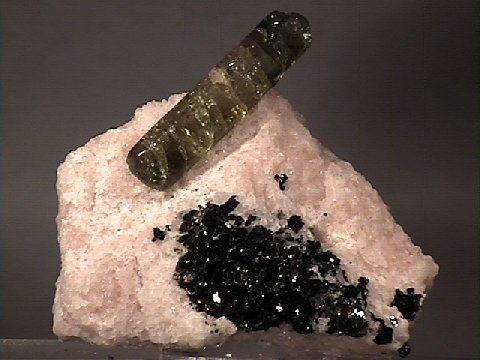
APATITE specimen apa-18
$ 105.00
$ 105.00
Dims: 2.3 x 2.0 x 1.3" (5.8 x 5.0 x 3.2 cm)
Wt: 3.0 oz. (85 g) w/ base
Liscombe Deposit, Monmouth Township, Wilberforce, Ontario, Canada
A single Apatite crystal rests on the calcite base of this hand specimen. This crystal has dimensions of 1.4 x 0.3 x 0.2" (3.5 x 0.8 x 0.5 cm) and is in excellent condition- it may have been broken and repaired, but if so, the repair job is excellent and impossible to determine with the naked eye. The crystal has rounded but definite trigonal prismatic form and a greasy-to-pearly luster. It is transparent and moderately clear, containing many parallel internal cleavage planes. Its olive-green color has a strong brown tint in one area. The calcite base on which it rests also holds a patch of broken biotite, and it is hot-glued to a small, flat acrylic base.


apa-18 ($105.00)
Liscombe Deposit, Monmouth Township, Wilberforce, Ontario, Canada
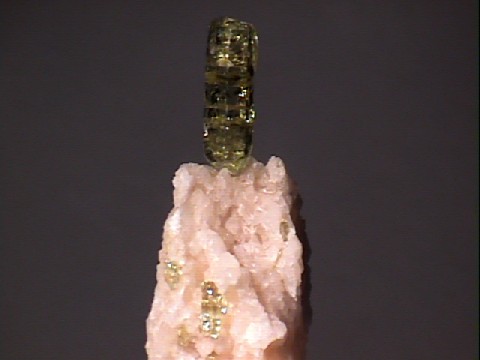
APATITE specimen apa-20
$ 25.00
$ 25.00
Dims: 2.0 x 1.0 x 0.9" (5.0 x 2.5 x 2.3 cm)
Wt: 1.0 oz. (27 g)
Liscombe Deposit, Monmouth Township, Wilberforce, Ontario, Canada
A few hexagonal Apatite prisms extend from the calcite base of this small hand specimen. The most notable of these crystals extends straight up from its base and measures 0.8" (2 cm) in length. It is in excellent condition, showing no fresh damage upon first glance, though the crystal has been broken and repaired. Its hexagonal form is very good, though edges are somewhat rounded, and its pale green color is standard for Apatite from this locality. It has been coated with vinac, which gives it a vitreous luster, and it is transparent and quite clear, though it contains parallel, base-oriented internal cleavage planes.

apa-20 ($ 25.00)
Liscombe Deposit, Monmouth Township, Wilberforce, Ontario, Canada
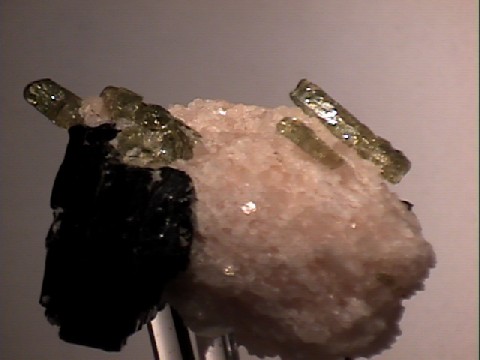
APATITE specimen apa-21
$ 45.00
$ 45.00
Dims: 2.5 x 2.1 x 2.1" (6.5 x 5.3 x 5.3 cm)
Wt: 5.5 oz. (157 g)
Liscombe Deposit, Monmouth Township, Wilberforce, Ontario, Canada
This small cabinet specimen consists of several intact and incomplete Apatite prisms that extend from a pink calcite matrix. About half of them are complete, and the largest reaches 0.9" (2.3 cm) in length. All have a somewhat rounded hexagonal prismatic form and show a pale olive-green color and a nearly vitreous luster. Though they contain many base-oriented internal fractures, they are transparent and at least moderately clear. They are accompanied by a cluster of intersecting phlogopite books that show some fresh cleavage and excellent pseudo-hexagonal form.

apa-21 ($ 45.00)
Liscombe Deposit, Monmouth Township, Wilberforce, Ontario, Canada
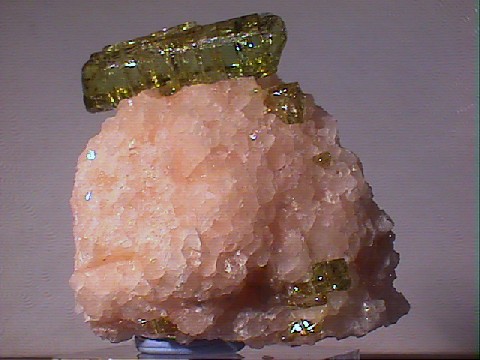
APATITE specimen apa-19
$ 60.00
$ 60.00
Dims: 1.6 x 1.6 x 1.1" (4.1 x 4.1 x 2.8 cm)
Wt: 1.8 oz. (52 g)
Liscombe Deposit, Monmouth Township, Wilberforce, Ontario, Canada
Several Apatite prisms are embedded in the pale pink calcite matrix of this hand specimen. The most noticeable of these is also the largest and likely the most complete, and measures 1.2" (3.0 cm) in length. It is obviously broken and damaged, as a small portion is missing near one termination- however, both terminations are intact. Its hexagonal form is somewhat rounded and its pale greenish-yellow color is standard for pieces from this locality. Its vitreous form might be due to a protective coating of Vinac varnish, and its clarity is only spoiled by many parallel internal cleavage planes.
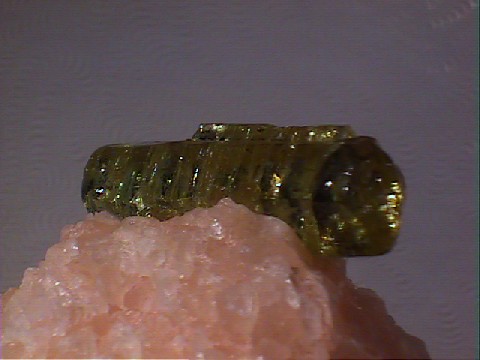

apa-19 ($ 60.00)
Liscombe Deposit, Monmouth Township, Wilberforce, Ontario, Canada
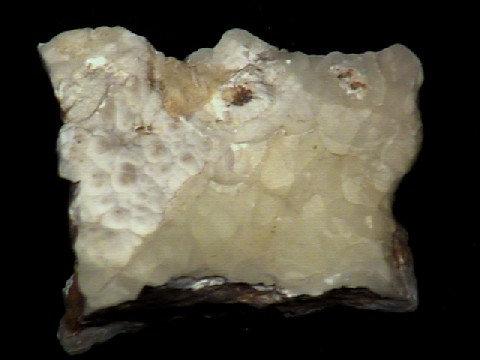
APATITE specimen apa-22
$ 30.00
$ 30.00
Dims: 1.41x1.19x1.04" (3.58x3.01x2.65cm)
Wt: 0.90oz (26.5g)
Staffels, Germany
This is a specimen of hydroxylapatite. It is present as a pale yellow and translucent crystalline crust on top of an opaque white botryoidal crust over a brown host rock. The hydroxylapatite crystals have a form that is difficult to describe. The curface is not botryoidal, because each dome consists of several nearly flat terminations that are only rounded in the agregate. It reminds me of some skutterudite specimens, although the individual crystals are quite small.


apa-22 ($ 30.00)
Staffels, Germany
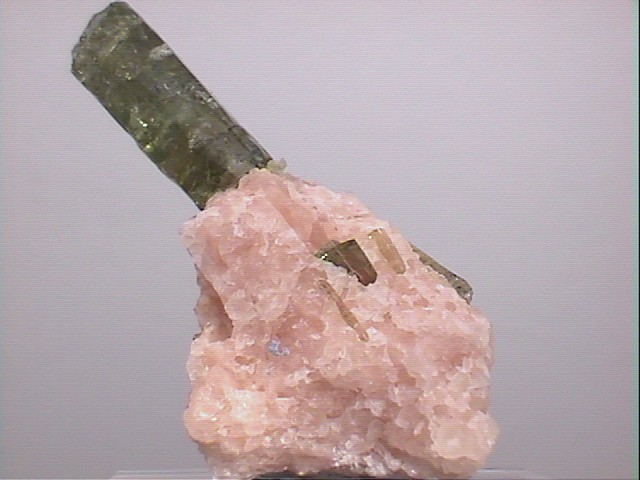
APATITE specimen apa-23
$ 55.00
$ 55.00
Dims: 2.46x1.31x0.79" (6.26x3.32x2.00cm)
Wt: 1.11oz (31.4g)
Liscombe Deposit, Wilberforce, Ontario, Canada
This is an exceptionally transparent green specimen of apatite. Of the half-dozen crystals on the host calcite, only one is large, measuring 9mm wide and 25mm long. While the surface has numerous imperfections marring the crystal's clarity, a loupe reveals that the apatite is extremely transparent. One of the smaller crystals is nearly perfect, displaying rounded terminations at both ends. The specimen has been repaired, as it appears that the large crystal has been glued to the matrix where it broke off, and a cleavage fracture has been repaired as well. In addition, the specimen has been coated with vinac to give it a vitreous luster.
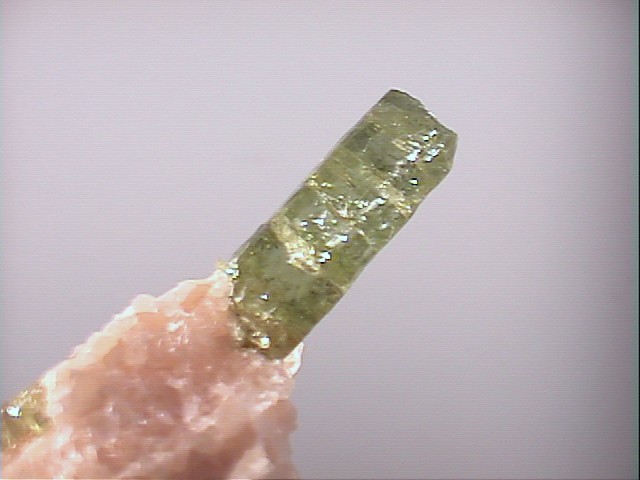

apa-23 ($ 55.00)
Liscombe Deposit, Wilberforce, Ontario, Canada
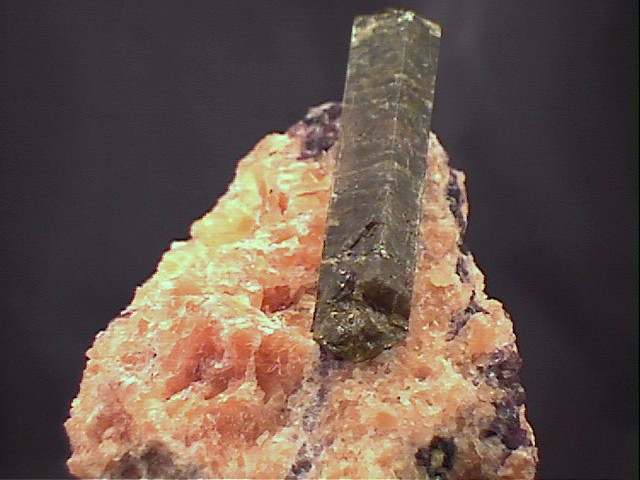
APATITE specimen apa-24
$ 45.00
$ 45.00
Dims: 2.83x2.31x1.58" (7.20x5.87x4.02cm)
Wt: 6.46oz (183g)
Yates Uranium Mine, Otter Lake, Quebec, Canada
This is a nice green apatite crystal with partial terminations at both ends. It is nicely perched on a chunk of orange calcite with multiple veins of purple fluorite. This is a colorful specimen. The apatite is transparent but has so many internal fractures (all parallel) that it looks translucent but with bright sparkles where the internal fractures catch the light. It has undoubtedly been removed from the matrix, cleaned, coated with something to improve its luster, and glued back into its original spot in the calcite.
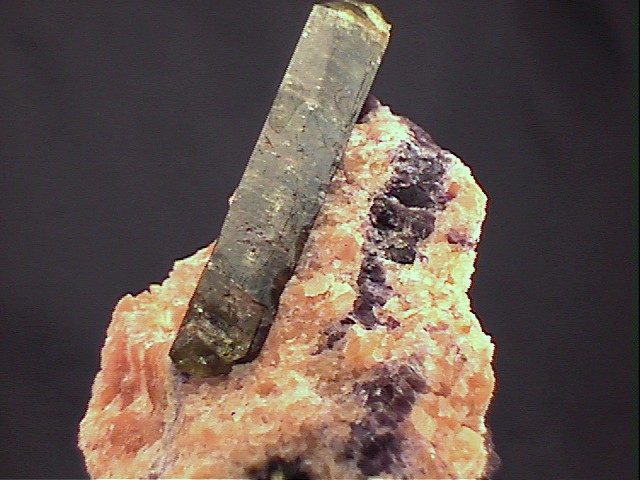

apa-24 ($ 45.00)
Yates Uranium Mine, Otter Lake, Quebec, Canada